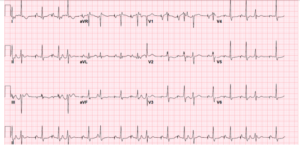
CC: Vomiting for 2 days
HPI: 32 yo female with PMH of Romano Ward Syndrome s/p AICD, previous cardiac arrest, Atrial Fibrillation s/p Ablation, renal artery thrombosis on Coumadin and deafness presents to the Emegency Department (ED) via ALS after being found unresponsive at home and with ventricular tachycardia. Paramedics state they were called to the patient’s home for an “unconscious” person. They arrived to find the patient lethargic but arousable, cool, pale, and diaphoretic with BP 90/50. The patient soon became unresponsive and was in Ventricular tachycardia on the monitor. Patient underwent synchronized cardioversion with 150 Joules and converted to sinus tachycardia. Patient also received 150 mg Amiodarone bolus and 250 mL of Normal Saline IVF. Patient’s sister arrived to ED approximately 10 minutes after patient’s arrival and states that patient had multiple episodes of becoming unconscious at home earlier today. Denied recent illness, fever/chills, vomiting, diarrhea
Physical Exam:
BP 133/105, HR 115 Sinus tachycardia, RR 20, SpO2 100% on 3 lpm NC, Temp 97.0F
General: Lethargic but arousable to painful stimuli
HEENT: NCAT, pupils PERRLA, neck supple
Respiratory: Moderate respiratory distress with bibasilar rales, otherwise clear, no wheezing
Chest: AICD in left anterior chest
Cardiac: +S1/S2, no MRG, tachycardia, regular rhythm
Abdomen: soft NT ND
Neuro exam: arousable to painful stimuli, pt reading lips, answering appropriately
Extremities: weak thready pulses throughout, no edema
Skin: cool, pale, diaphoretic, no rashes, lacerations, or abrasions
Labs:
CBC: Unremarkable CMP: K 3.2 Glucose 595 BUN/Cr 17/1.62
AST/ALT 359/401 INR: 1.7 Troponin 0.122
ED Course: Approximately 5 minutes after arrival to the ED during the initial exam, patient became unresponsive and was noted to be in Ventricular Fibrillation on the monitor. CPR/ACLS was started and patient was intubated immediately. Her defibrillator appeared to be delivering shocks however there was no conversion of the rhythm. ACLS was performed for 30 minutes and pulses were regained multiple times. Patient was in V-fib, then PEA, then V-tach arrest. 100mg Lidocaine and 2 grams Magnesium were also given. Defibrillation with external pads ultimately led to Return of Spontaneous circulation. Bloody, frothy sputum was also noted from the ETT post-arrest. A right IJ central line was placed
EKG:

Pre-arrest: Atrial-paced with PACs. QTc 503 Post-arrest: Atrial tachycardia. QTc 609
DX: VFib & VTach arrest s/p ROSC in the setting of Congenital Long QT syndrome and AICD non-capture.
ED/Hospital course: Post-ROSC EKG did not show STEMI. Post-ROSC Chest XR demonstrated diffused pulmonary edema. Patient was hypoxic with SpO2 in the 80s on 100% FiO2. Decreased tidal volume and increased PEEP improved oxygenation. Bedside cardiac Ultrasound showed global hypokinesis and no pericardial effusion. CT Head w/o contrast was normal. Amiodarone drip was started. Hypothermia protocol was initiated. The patient was admitted to the CCU. She did not code again while in the ED. Her AICD was interrogated and it showed she had been in sustained Vtach to which her AICD gave multiple shocks without capture. She was in the hospital for 11 days where she initially was improving and was therefore extubated after 7 days. Unfortunately she again went into Vtach arrest multiple times and then PEA arrest and was pronounced dead.
Pearls:
Congenital Long QT Syndrome (LQTS)
- The major variant of congenital prolonged QT syndrome (there are 6 total). Affects estimated 1/2500 to 1/7000 people worldwide
- Can have varying degrees of penetrance
- Thought to account for ~3000/year of sudden deaths in children
- May play a roll in prevalence of SIDS
- Autosomal dominant inheritance, results in mutation of genes responsible for creating ion-channel proteins. The impaired transport of ions in cardiac tissue causes prolonged QT à impaired repolarization à ventricular arrhythmias (symptomatically syncope, seizure, cardiac arrest). May also present with AV blocks and bradydysrhythmias.
- Romano-Ward is the more common, autosomal dominant (AD) form with purely cardiac phenotype.
- The Jervell and Lange-Nielsen syndrome refers to the autosomal recessive (AR) phenotype of congenital LQTS that is associated with profound sensorineural hearing loss and a high risk for sudden death. MORE MALIGNANT CLINICAL COURSE. Our patient likely had this variation since she also had deafness.
Management and treatment
- Beta- blockers = 1st line treatment in symptomatic patients. Blunts catecholaminergic response
- Whenever syncopal episodes recur despite full-dose beta-blocking therapy, left cardiac sympathetic denervation (LCSD) should be considered. Cardiac pacing is only rarely indicated (e.g. in infants or young children with 2:1 atrioventricular block).
- Implantable cardioverter defibrillators (ICDs) are always indicated after cardiac arrest, or when requested by the patient, and whenever syncope recurs despite beta-blockade and LCSD.
- Potassium supplementation or spironolactone
- Other antiarrhythmic therapy based on genotype
Risk Factors for syncope or SCD
- Congenital deafness
- Hx/o syncope
- Hx/o Ventricular arrhythmia
- Family hx/o SCD
- Female gender
- QTc > 600ms
- Medical non-compliance
Event triggers (vary depending on which genetic mutation)
- Exercise-related
- Auditory stimuli (alarm clock, telephone ringing!)
- Acute emotional events
- Catecholamine-induced
- Pregnancy and up to 9 months post-partum
- Onset of menopause
Post by Katrina D’Amore, DO.
